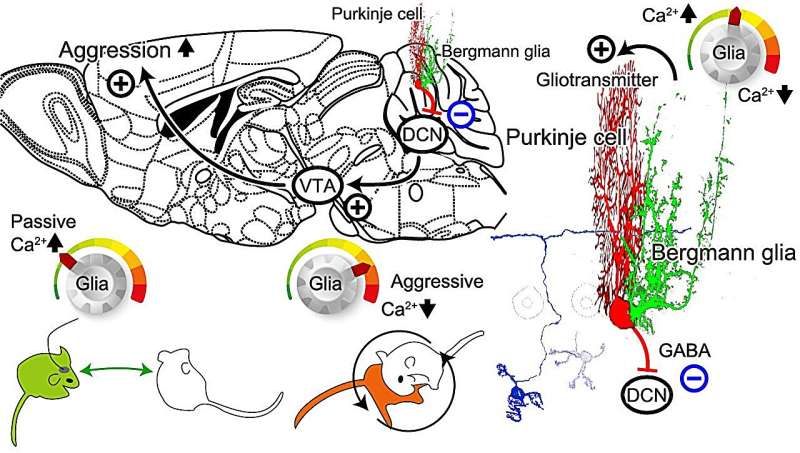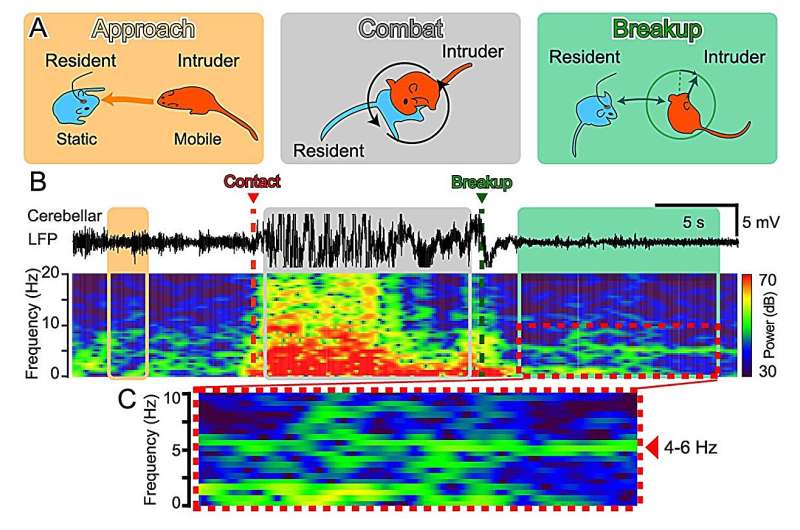This article has been reviewed according to Science X's editorial process and policies. Editors have highlighted the following attributes while ensuring the content's credibility:
fact-checked
trusted source
proofread
Neuron–glial interactions in the cerebellum involved in aggressive behavior, study shows

Aggression is often associated as a negative emotion. Uncontrolled aggression can lead to conflict, violence and negative consequences for individuals and society. Yet that does not mean that aggression serves no purpose. It is an instinctive behavior found in many species that may be necessary for survival. The key is managing and channeling aggression.
In a recent study using mice, researchers at Tohoku University have demonstrated that neuron–glial interactions in the cerebellum set the tone of aggression, suggesting that future therapeutic methods could rely on adjusting glial activity there to manage anger and aggression.
The findings were detailed in the journal Neuroscience Research on November 24, 2023.
Scientists have recently recognized the role of the cerebellum in non-motor functions such as social cognition. A malfunctioning cerebellum can be seen in autism spectrum disorders and schizophrenia, leading to social interaction difficulties. In particular, it has been reported that a region of the cerebellum, known as the vermis, is associated with aggression in humans. Therefore, the researchers investigated the possibility that Bergmann glial cells in the cerebellar vermis regulate the range of aggression in mice.
"Cells in the brain can be divided into neurons and glia, and although glia occupy approximately half of the brain, their participation in the brain's information processing, plasticity, and health has long been an enigma," says Professor Ko Matsui of the Super-network Brain Physiology lab at Tohoku University, who led the research. "Our newly created fiber photometry method provides a gateway for understanding the physiology of glia."

Matsui and his colleagues employed the resident-intruder model, where one mouse (the intruder) goes into the territory of another mouse (the resident). When the unfamiliar male mouse enters the cage, quite commonly, a series of fights break out between the resident male mouse and the intruder. Each combat round lasted about 10 seconds, and these rounds were repeated at a frequency of approximately one per minute. The superiority and inferiority of the resident and intruder dynamically switched within each combat round.
The fiber photometry method revealed that intracellular Ca2+ levels in cerebellar glia decreased or increased in conjunction with the superiority or inferiority of the fight, respectively. When the combat broke up, the researchers observed 4 to 6 Hz theta band local field potentials in the cerebellum, along with a sustained increase in Ca2+ levels in the glia. Optogenetic stimulation of cerebellar glia induced the emergence of the theta band, causing an early breakup of the fighting.
Glia have been shown to control the local ionic and metabotropic environment in the brain and also to release transmitters that can affect neuronal activity in the vicinity. The results of this study suggest that the theta band cerebellar neuronal activity is regulated by the activity of Bergmann glial cells, thereby demonstrating that cerebellar glial cells play a role in regulating aggression in mice.
Lead study investigator, Yuki Asano, says that future anger management strategies and clinical control of excessive aggression and violent behavior may be realized by developing a therapeutic strategy that adjusts glial activity in the cerebellum. "Imagine a world without social conflict. By harnessing the innate ability of the cerebellar glia to control aggression, a peaceful future could be become reality."
More information: Yuki Asano et al, Glial tone of aggression, Neuroscience Research (2023). DOI: 10.1016/j.neures.2023.11.008

















